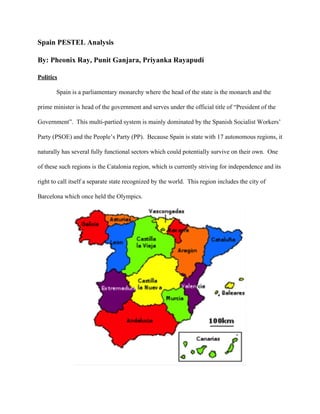
Spain PESTEL Analysis: Politics, Economics, Society, Technology, Environment & Catalonia Independence
- 2. Basque Country, Catalonia, Galicia and Andalusia are mainly the provinces of Spain that could be described as their own nation. In fact, there is currently must dispute about the autonomy of these regions. One such example is Catalonia which has for several years and with growing interest, started to protest for its own independence. Although they provinces have finally been given the right to practice their own traditions and speak their own languages, they have found themselves wanting to separate from the country of Spain. Corruption has been a raising issue among public officials in Spain. Their questionable activities include frude, bribery, nepotism, and much more. This lack of integrity could lead to an unhappy populace, followed by an unstable government. While this does not automatically negate Spain as a potential country to invest in, it could raise some concerns about possible future rebellions and political instability. Economics Having a 7.6 freedom score, Spain claims the 49th freest economy in the 2015 index. Increasing by a small .4 from last year, we still see an encouraging growth in this budding country as it emerged into the “moderately free” category within the past five years. While this is not greatly impressive, it is still a growth from the severe recession that it saw from the 2008 dip. Referring to the graphs below, we can see that Spanish unemployment rates were increasing exponentially, and that industrial production was decreasing. Sales went down, and exports took and disastrous dip. This decline in the market lead to severe deficits and increase in debt. Now has come the time for Spain to start paying off its debts, but it is at a loss on how to come up with the large amounts of money.
- 10. ∙ Source: United Nations Environmental Program and the World Conservation Monitoring Centre, as compiled by the World Resources Institute, based on data from national authorities, national legislation and international agreements. Year Value 1990 6.38 1991 6.61 1992 6.65 1993 6.68 1994 6.93 1995 7.12 1996 7.23 1997 7.49 1998 7.51 1999 7.57 2000 7.57 2001 7.58 2002 7.62 2003 7.63 2004 7.63 2005 7.63 2006 7.63
- 11. 2007 7.63 2008 7.63 2009 7.63 2010 7.63 ∙ Sept 21, 2014. According to the newspaper, El Mundo, the province of Alicante in the south east is suffering the worst drought in history. The article starts dramatically: "The products of Alicante are dying of thirst." The average precipitation for the last 12 months (Aug. 31, 2013Sept.1, 2014) has been 153.6 liters per square metre compared to an average of 426.4 l/sq.m. between 1981 and 2010. From Aug. 2103 to Sept. 2014, 69.8 l/sq.m. of rain fell in the city of Alicante where normally it could expect around 311 l/sq.m. The impact on agriculture, a major economic resource heavily dependent on irrigation, has been disastrous. Even drought resistant olive and almond trees are affected. In addition, warmer than usual winters have also contributed to the problem. Exported goods such as artichokes, broccoli, lettuce, celery and potatoes are especially affected. To add fire to the fuel, The European Union has withdrawn subsidies vital for helping alleviate the effects of the drought. ∙ Renewable energy in Spain represented 42.8% of total energy generation in 2014. Overall 27.4% of Spain's electricity was generated from wind and solar in 2014. Spain has set the target of generating 45% of its energy needs from renewable energy sources. Spain is the world's fourth biggest producer of wind power. In 2014, the yearend installed capacity was 23 GW and the annual production was 51,439 GWh, a share of total electricity consumption of 21.1%. ∙ Laws and Regulations: Spanish environmental laws derive from the transposition of EU legislation. The main regulated fields are: 1. Integrated Environmental Control 2. Natural Heritage and Biodiversity protection
- 13. A 50% Social Security fee reduction during the next 6 months after the previous period of time; A 30% Social Security fee reduction during the next 6 months after the previous period of time. Furthermore, an Autónomo must comply with several tax obligations, mainly to present its quarterly declarations of taxes relating VAT and Retentions made by other professionals. 7. Spanish Limited Company A Limited Company is the legal structure most used in Spain to start a company. As stated above, it is necessary to hold a NIE to become a shareholder of a Company. The main steps to incorporate a Limited Company are as follow: a. First of all, it is necessary to obtain the Name of the Company through a Certificate issued by the Companies Registry (Registro Mercantil). b. The next step is to open a bank account and to deposit the minimum share capital to incorporate a Limited Company, which is 3.000 euros. The Bank will issue a Certificate of deposit that shall be presented at a Public Notary. c. Both Certificates are necessary to incorporate the Limited Company before a Public Notary. All the shareholders will have to be present and sign the deed and the Articles of Associations of the Company. d. After signing the deed, it will be necessary to obtain the Tax Identification Number of the Company (NIF = Número de Identificación Fiscal). e. Finally, the incorporation of the Company will have to be registered at the Companies Registry, and the beginning of the activity shall be notified to the Tax Administration. Bibliography Data.worldbank.org,. 'GINI Index (World Bank Estimate) | Data | Table'. N.p., 2015. Web. 19 June 2015. Poverty.org.uk,. 'European Union: Gini Coefficient The Poverty Site'. N.p., 2015. Web. 19 June 2015.
